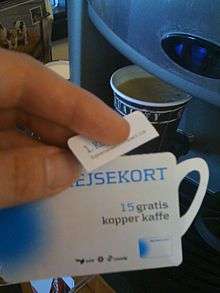Rejsekort
Rejsekort (Official translation: TRAVEL CARD) is an electronic ticket system for public transport in Denmark. The system is a collaborative work between DSB, HUR, Ørestadsselskabet, and various regional bus companies, and work on it started on August 18, 2003. In June 2005, the Thales Group and Accenture were chosen as suppliers.
 | |
| Location | Denmark |
|---|---|
| Launched | Implemented |
| Manager | Rejsekort A/S |
| Currency | DKK (also prices and balance are shown in EUR in rejsekort automates) |
| Stored-value | Prepaid card |
| Credit expiry | None |
| Auto recharge | Auto top-up |
| Validity | |
| Retailed |
|
| Website | rejsekort.dk |
The total cost of the system will be between €200 and €270 million.
Overview
The system has replaced the old zone ticket system. Instead, fares are calculated from the distance made from the beginning of the journey to the end, as the crow flies, so as to give a better correlation between price and distance travelled. Like the old system, the Rejsekort is designed to work universally for trains, buses, and metro trains.
Either a superpersonal, a personal or an anonymous card is issued to passengers. The superpersonal card has a picture of the owner on it, and only the owner (or the owner and one or more travelling companions) is able to use it. The personal card is attached to an owner, but everyone can use it, e.g., friends or family members. The anonymous card is not attached to an owner.
The card must be checked in at a card reader (either at a train platform or on board a bus) at the start and the end of a journey, and the system automatically calculates the price of the journey; failure to check in results in a fine. The money is deducted from a prepaid account; alternatively, a card can be signed up for a payment scheme so that the money is automatically deducted from the holder's bank account. The more trips a passenger makes per month, the less money each trip will cost. The old discount system worked that way, too; however, the system was limited to a set number of zones, while the new discount system applies nationwide.
There are no ticket gates at stations, because it would lead to closing many smaller entrances, and thus it would take longer time to check in, and it would be costly to introduce at the many small stations. Instead, a proof-of-payment system is used.
There has been criticism against the cost overrun and delay, and to some user problems. For example, people who forget to check out need to pay extra, and that the onboard GPS can give delayed position at when checking in, resulting in too high a price being charged. Receipts are not given, and the trips can be checked online only after a few days, making it hard to verify that the correct amount was paid.
It was expected that Skånetrafiken in Scania in Sweden would implement a system akin to the Danish. Therefore, the Rejsekort system was prepared to work with the Scanian, so as to allow passengers to easily travel over the Oresund Bridge. The current cross border paper tickets are also accepted on local traffic, and should do so also in the future. Skånetrafiken did in 2009 introduce a different electronic card system, which is incompatible with Rejsekort. The new Skånetrafiken system is electronic only for buses, while for trains a paper ticket must be printed. Neighbour counties in north introduced the same system but under own names.
The implementation of Rejsekortet is considered to be one of the biggest IT scandals in Denmark. This due to the not very successful end product, the doubled price-tag and the extreme delay in the original project plan.
Timetable for implementation
The Rejsekort system was tested between Roskilde and Tølløse in December 2007. Plans to roll the system out to the whole of Zealand in 2008 and 2009 have been shelved due to delays, and have instead been replaced with the following timetable:[1]
- Testing between Taastrup and Holbæk at the end of 2008
- Rollout to paying customers between Taastrup and Holbæk at the start of 2009
- South Zealand at the end of 2009
- West Zealand in the beginning of summer 2010
- Capital Region of Denmark (essentially Copenhagen and surrounding areas) in the autumn of 2010
- North Jutland in the autumn of 2010
- DSB's stations on Funen and the rest of Jutland in the autumn of 2010
- The rest of the busses in Jutland and Zealand in the autumn of 2011, and soon after all railways in the capital.
- In 2015 old paper punch cards aren't sold anymore, leaving rejsekort and more expensive single tickets as the main options.
See also
References
- "Danish Rejsekort timetable (in Danish)". Retrieved 2008-08-11.